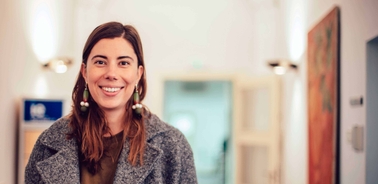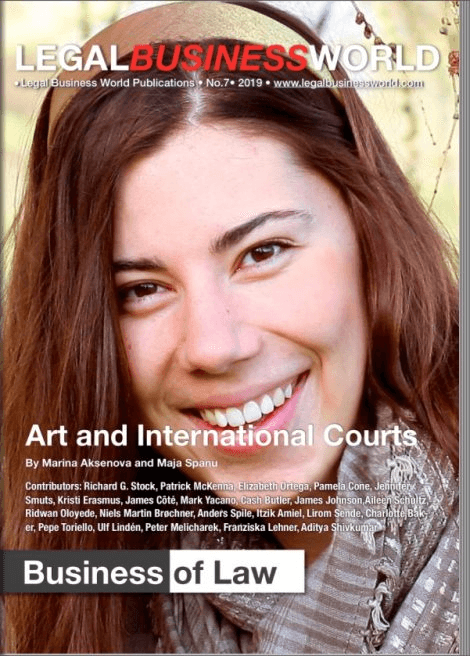- Home
- We Are Law School
- News
- Bringing Together Art And International Justice
Bringing together Art and International Justice

Professor Marina Aksenova lands the cover of Legal Business World with her article on the need for exploring the interaction between art and international justice at all levels.
Over the years, numerous authors have therefore focused on law as a social practice creating and created by individuals and groups, whether in the field of international law or in other disciplines such as International Relations, sociology, psychoanalysis, ethics and communication. Looking at international law as sets of practices rather than just normative outcomes has therefore opened up a multitude of approaches and understandings to international law.
Our first ARTIJ workshop on ‘Art and International Courts’ co-organized with iCourts at the University of Copenhagen on 25-26 April 2019 aimed to open up a discussion on what we deem is an overlooked aspect of the practice of international law, namely the relationship between art and international courts, as the loci where and through which international law is most obviously performed. What is the role that art plays in the discourse and practice of international law? How do aesthetics – whether understood as the study of visual, sensorial or rhetorical expressions - shape perceptions of law and courts? To what extent do they matter, across time and space, in the law’s actualization? How have different forms of art been used by courts, and for what purpose? How do international law and international courts deal with cultural heritage and protection of art? Bringing together a number of scholars working across law, International Relations, sociology, history and philosophy as well as artists this two-day workshop thus aimed to initiate a new and interdisciplinary conversation directly tackling these questions.
Looking at international law as sets of practices rather than just normative outcomes has therefore opened up a multitude of approaches and understandings to international law.
At ARTIJ, we engage with different forms of ‘art’, including visual art, fine art, performative art, moving art and applied art. In the context of this workshop we thus wanted to operate with a similar understanding of the concept to allow for the widest possible conversation. The challenge of defining art for the purposes of an academic discussion (no matter how transdisciplinary this conversation may be) is that in its widest possible sense, art lies beyond concept and therefore beyond description and categorization. Yet, we do believe that it is possible to distill and discuss art in a number of ways: art as experience, art as emotion, art as a form of representation of reality, art as a set of practices, as well as art’s functions across time and space. Moreover, a focus on art allows connecting all the actors involved in the processes of conceiving, making and receiving the artwork. The objects of art - whether explicitly called as such, as in the context of an exhibition, or in the form of a decorative item placed in a building hosting a legal institution- are the carriers of meaning both intended by the creator and attributed to them by the person experiencing the object in question.
We suggest that three core reasons define the need for exploring the role of art in the practice of international courts, directly connecting with the various contributions to our workshop and ensuing symposium.
Firstly, art is an inalienable feature of any social practice, international law included. Some art theory is helpful in explaining this point. John Dewey in particular eloquently argued that in the course of history art became artificially separated from the conditions of its creation.
Dewey points out that art traditionally was a manifestation of the processes and tasks of everyday life, such as worship, war or hunting – “all the rhythmic crises that punctuate the stream of living”. Later on, and especially in Europe, art became increasingly confined to closed spaces only accessible to some such as museums, opera houses and so on. Yet, it is undeniable that there is an obvious continuity between artworks and everyday events and practices. For instance, the Greek Parthenon in Athens’ acropolis is regarded today as an art masterpiece. However, it was originally designed and built as a temple dedicated to civic commemoration. In a way not dissimilar to the past, the Peace Palace in the Hague was built at the beginning of the 20th century with the intention of transforming it into the ‘temple of peace and justice’. The building though also presents an incredibly rich décor, including manifold artworks, making of it not just the temple but also the museum of peace and justice, at a given point in time.
International law is a social practice concerned with issues of interest to the multitude of states and actors operating within them. If one accepts Dewey’s position that art is inherent in social life, then it is easy to see how artistic practices accompany the administration of international law. Art is inherently part of the process of international justice through architecture of the courthouses, through judicial rhetoric, through iconography and other forms of expression. A number of contributions at the workshop thus sought to shed light onto this ‘hidden’, or unspoken, aspect of international justice and examine what questions and contradictions it may hold. Mark Drumbl’s contribution speaks directly to this latter point. The author investigates the rituals of commemoration, remembrance and tribute stemming from the activity of international courts. In particular, Drumbl draws attention to the celebration in Japan of Judge Pal, an enthusiastic dissenter at the post-World War II Tokyo War Crimes Tribunal organized by the Allies, winners of the war. In his contribution, Drumbl argues that visuality brings with it unintended consequences, it opens up the space for a multitude of interpretations.
Jayati Srivastava’s contribution explores, in turn, international justice’s iconography. She points out that its emblems and symbols serve representational purposes whilst carrying specific meanings. This, the author claims, is visible for instance in the simple architecture and in the logo of the International Criminal Court (ICC), both seeking to convey notions of trust and transparency. Yet, Srivastava tells us, these aspirational messages are in clear opposition to current international criminal justice, which in practice is both hierarchical and imbalanced. The tension between ethics and aesthetics that the author uncovers stresses the discord between symbolic and substantive justice. Miriam Bak McKenna further explores the dichotomy between the aspirations and the actual reality of international justice reflected through aesthetics. More specifically, McKenna investigates the architectural design of international courthouses, drawing particular attention to the ICC structure: while the ICC was created with the ideas of internationalism in mind, the architectural aesthetic of the building is reminiscent of the sleek, glass structures common in Northern Europe.
In his piece on international justice and photography, Raphael Oidtmann ponders about the role of photography in eliciting truth.
Read the complete article published in Legal Business World here
About the Authors
Marina Aksenova is Professor IE Law School at IE University and Director ARTIJ Initiative.
Maja Spanu is Junior Research Fellow in International Relations at the University of Cambridge.
Marina Aksenova and Maja Spanu are the co-founders of ARTIJ, which brings together art and international justice.
